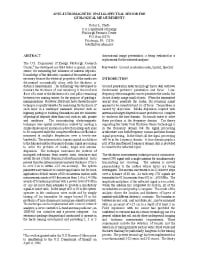Mining Publication: An Electromagnetic Spatial/Spectral Sensor for Geological Measurements
Original creation date: September 1996
Authors: RL Chufo
NIOSHTIC2 Number: 20023297
Proc Sixth International Conference on Ground Penetrating Radar 1996 Sep 30 - Oct 3 Sendai, Japan Tohoku University, Dept. of Geoscience and Technology, 1996; :545-547
The U.S. Department of Energy Pittsburgh Research Center, has developed and field tested a spatial, spectral 1 sensor for measuring the thickness of mineral deposits. Knowledge of the dielectric constant of the material is not necessary because the electrical properties of the media are determined automatically along with the thickness or distance measurement. The technology was developed to measure the thickness of coal remaining in the roof and floor of a mine or the thickness of a coal pillar remaining between two mining entries for the purpose of guiding a mining machine. However, field tests have shown the new technique is equally valuable for measuring the thickness of each layer in a multilayer manmade structure such as highway paving or building foundations and the thickness of geological deposits other than coal, such as, salt, granite and sandstone. The noncontacting electromagnetic technique uses spatial modulation created by moving a simple dipole sensor antenna in a direction along each axes to be measured while the complex reflection coefficient is measured at multiple frequencies over a two-to-one bandwidth. The antenna motion imparts spatial modulation to the data and enables frequency domain signal processing to solve the problem of media, target and antenna dispersion. The technique overcomes the problem of multipath reflections from nearby metal structures and avoids the use of radio frequency absorbing material. In its present form the system measures material thickness of zero to over 3 m to within ±2.5 cm accuracy. The system parameters are variable to suit the application but for most applications default values of 40 cm antenna motion with measurements made at 401 frequencies from 0.6 to 1.4 GHz at each of 32 antenna positions with a power level of 0 dBm or less are more than adequate to provide a satisfactory signal-to noise ratio. In the range of 0 to 10 m the system operates in the continuous wave mode and by simply turning off the transmitter for ranges beyond 10 m the problems of time domain processing are entirely avoided. The technique can be implemented with a vector network analyzer, a servo controlled L-band antenna positioner, an IEEE488 bus controller and a process computer. An electronics package designed and constructed to operate in the harsh mining environment and providing 1, 2 or 3 dimensional image presentation is being evaluated as a replacement for the network analyzer.

NIOSHTIC2 Number: 20023297
Proc Sixth International Conference on Ground Penetrating Radar 1996 Sep 30 - Oct 3 Sendai, Japan Tohoku University, Dept. of Geoscience and Technology, 1996; :545-547
- Application of Ground Penetrating Radar to Evaluate the Extent of Polyurethane Grout Infiltration for Mine Roof Control: A Case Study
- Assessment of Ground Conditions Near a Mine Portal Using Ground Penetrating Radar
- Evaluation of Mine Seals Using Ground Penetrating Radar
- Magnetic Field Strength Mapping of the Helvetia Coal Co. Lucerne No. 8 Mine at Medium Frequency
- Proceedings of the International Workshop on Rock Mass Classification in Underground Mining
- A Radar-based Highwall Rib-Thickness Monitoring System
- Recent National Institute for Occupational Safety and Health Research Using Ground Penetrating Radar for Detection of Mine Voids
- Technology News 462 - Ground Penetrating Radar for Highwall Guidance
- Use of Ground Penetrating Radar and Schmidt Hammer Tests to Determine the Structural Integrity of a Mine Seal
- Using Ground Penetrating Radar for Roof Hazard Detection in Underground Mines